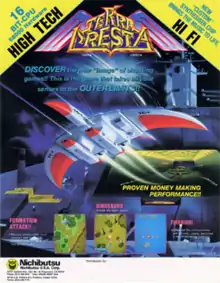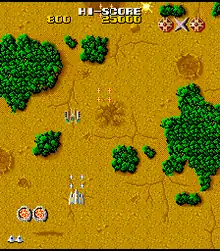Terra Cresta
Terra Cresta[lower-alpha 1] is a 1985 vertical-scrolling shooter arcade game developed and published by Nichibutsu. The player assumes control of a starship named the "Wing Galibur" that must destroy the Mandler army before they destroy all of humanity. Gameplay involves shooting enemies and collecting different ship parts that each provide their own unique weapon, such as a wave gun or a double shot. It is the sequel to Moon Cresta (1980), Nichibutsu's first big hit in arcades.
| Terra Cresta | |
|---|---|
 Promotional sales flyer | |
| Developer(s) | Nichibutsu |
| Publisher(s) | Nichibutsu |
| Designer(s) | Shigeki Fujiwara |
| Series | Terra Cresta |
| Platform(s) | |
| Release | |
| Genre(s) | Vertical-scrolling shooter |
| Mode(s) | Single-player, multiplayer |
Gameplay

The player takes control of the "Wing Galibur" fighter craft, and must shoot down the incoming enemy craft in the air and on the ground. Small capsules can appear on the ground, and once the player has shot all of them down, will award the player with a piece to attach onto the Wing Galibur. These pieces can give the Wing Galibur extra firepower and wider shots, with four individual pieces to acquire; should the player have all pieces to the ship and press the "transform" button, the Wing Galibur will transform into an enormous, flaming phoenix that is invulnerable to anything for a brief period of time.[1] Additionally, the player can press the transform button without all pieces, and cause the pieces to split from the Wing Galibur and move into a triangular shape around the player. During this, the pieces are invulnerable to all enemy fire, while the player is not; should he or she be hit with the pieces, the Wing Galibur will revert to a singular craft, and if the Wing Galibur is hit, the player will lose a life, and the game will be immediately over should the player lose all of their lives.
Reception
| Publication | Score |
|---|---|
| AllGame | |
| Your Sinclair | 7/10[3] |
| Computer Gamer | 70%[4] |
| Family Computer Magazine | 20/30[5] |
| VideoGame |
In Japan, Game Machine listed Terra Cresta on their October 15, 1985 issue as being the third most-successful table arcade unit of the year.[7]
In a 2016 retrospective review, Hardcore Gaming 101 compared the game to Super Mario Bros. in terms of taking concepts established in its predecessor and expanding on it while adding its own unique ideas alongside.[8] They greatly praised Terra Cresta for its unique power-up system in particular, namely the ability to split the different ships apart for a short while, and favorably compared the gameplay itself to Xevious for its design and challenge, alongside its several nods to Japanese science-fiction shows and mecha.[8] Hardcore Gaming 101 also praised the Nintendo Entertainment System version's soundtrack for being an improvement over the Japanese Family Computer score.[8] In their coverage of the series in 2016, Retro Gamer magazine liked the game's enhancements over titles like Xevious, alongside its "then-contemporary" power-up system.[9]
Legacy
Terra Cresta was ported to several home systems. European publisher Imagine Software produced conversions for both the ZX Spectrum and Commodore 64, while Nichibutsu themselves published a version for the Family Computer in Japan. The Famicom release was later published in North America for the Nintendo Entertainment System by Vic Tokai; it features a few alterations from the Japanese version, such as a remade soundtrack and the ability to customize the position of the player's ships when they separate from formation.[8] In 1992, Japanese developer Dempa ported both Terra Cresta and its predecessor Moon Cresta to the Sharp X68000 as the debut title in their Video Game Anthology line of arcade game re-releases, titled Video Game Anthology Vol. 1 - Moon Cresta / Terra Cresta.
Terra Cresta was released for the PlayStation 2 by Hamster Corporation in 2005 as part of their Oretachi Gēsen Zoku series, including, among other things, a mini soundtrack CD and a replica instruction card.[10] Hamster later released Terra Cresta digitally for the PlayStation 4 in 2014 and the Nintendo Switch in 2018, both being published under the Arcade Archives series. The Famicom version was digitally re-released for Microsoft Windows in 2014 by D4 Enterprise , released for their Project EGG service.[11] After acquiring the entirety of Nichibutu's video game library in 2013, the rights to Terra Cresta are now owned by Hamster.[12]
References
- "Terra Cresta - Videogame by Nihon Bussan".
- Knight, Kyle (1998). "Terra Cresta - Review". Allgame. Archived from the original on 17 November 2014. Retrieved 29 February 2020.
- Berkmann, Marcus (March 1987). "Terra Cresta" (15). United Kingdom: Imagine Publishing. Your Sinclair. p. 22. Archived from the original on 9 April 2016. Retrieved 29 February 2020.
- "Terra Cresta" (23). United Kingdom: Argus Specialist Publications. Computer Gamer. February 1987. p. 22. Retrieved 29 February 2020.
- "5月10日号特別付録 ファミコンロムカセット オールカタログ" (Volume 7, Number 9). Tokuma Shoten. Family Computer Magazine. 10 May 1991. p. 229.
- "Terra Cresta" (in Portuguese) (Volume 1, Issue 1). Brazil: Sigla Editoria. VideoGame. 1991. p. 22. Retrieved 29 February 2020.
- "Game Machine's Best Hit Games 25 - テーブル型TVゲーム機 (Table Videos)". Game Machine (in Japanese). No. 270. Amusement Press, Inc. 15 October 1985. p. 25.
- Ragan, Jess (9 July 2016). "Terra Cresta". Hardcore Gaming 101. Archived from the original on 21 November 2019. Retrieved 29 February 2020.
- Mason, Graeme (30 November 2018). "The Definitive Moon Cresta" (175). United Kingdom: Imagine Publishing. Retro Gamer. pp. 38–43.
- Gantayat, Anoop (5 August 2005). "More Arcade Retro Fun for PS2". IGN. Archived from the original on 20 October 2012. Retrieved 29 February 2020.
- "「プロジェクトEGG」で「テラクレスタ(FC版)」「ザ・ナイトオブワンダーランド(FM-7版)」の配信がスタート". 4Gamer.net. Aetas. 29 October 2014. Archived from the original on 9 November 2019. Retrieved 29 February 2020.
- "Press Release" (PDF) (in Japanese). Hamster Corporation. 14 March 2014. Archived from the original (PDF) on 27 September 2019. Retrieved 29 February 2020.